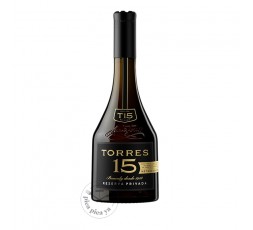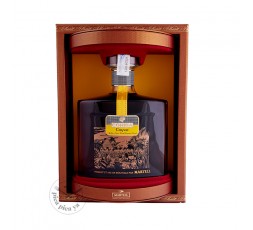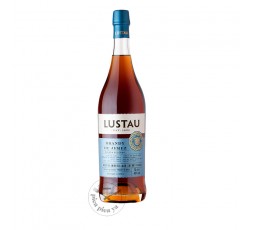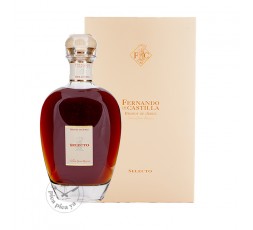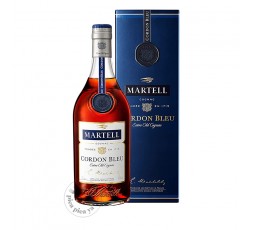No products

Brandy Ximénez-Spínola Diez Mil Botellas
Ximénez-Spínola
BR013
New product
3
Before
95,75 € Tax included
Distilling Pedro Ximénez is not easy. Extracting the nuances of the aromas from it and making them remain in a Castaño barrel seems atypical. However, the most complicated thing is to make the silkiness of the toasts and the memory of the raisins integrate with the alcohol. Here is the result.
| Volume | 75cl |
| Spirit | Brandy |
| Country | Spain |
| Alcohol content | 40,0% |
| Contains case | Yes |
| Grape | Pedro Ximénez |
Distilled from the wines of their House, which is part of the first phase of the aging process of the rest of the brandies they make. Once distilled from Pedro Ximénez, the extracted alcohols are aged in 750-litre Castaño wooden barrels, which have been previously seasoned with our Pedro Ximénez raisin wine.
Chestnut was the basic wood for cooperage in Jerez, before 1939, the date on which deforestation caused by the civil war forced it to be replaced by American Oak. This distillate remains for a minimum of 12 years in Castaño barrels, before being bottled. In other words, we are facing the distillate that is as similar as possible to the Brandy that was drunk in Spain until the middle of the 20th century. Honestly nobody does, to this day, any similar elaboration.
The particularity of Chestnut is that it is a wood that does not provide excessive astringent notes. Its flavors and aromas are basically oxidation, being so respectful of the original product, that it even helps the aromatic and taste memory of the Pedro Ximénez grape itself to survive.
It is an amber-colored distillate, clean, bright and particularly pale, without rims thanks to the neutrality of the Chestnut. Its not excessively intense color contrasts with its 12-year aging and is proof that the wood has been extremely respectful in all phases of the tasting, including the visual one.
On the nose it is intense but not heavy, with aromas reminiscent of raisins and plums, typical of the vinification of our Pedro Ximénez barrels as it ages. The persistence of the aroma does not come from the wood and is basically due to oxidation, being an elegant fragrance with a non-aggressive intensity.
On the palate it maintains a serene balance, allowing the quality of the original aged wine distillate to be appreciated. Subtle aftertaste of natural sweetness that helps to smooth the alcoholic edges, until they are almost imperceptible. It maintains intense touches of an enveloping wood that does not add bitterness and makes it especially pleasant on the palate. It invites you to continue drinking as it does not burn your throat either despite its 40º alcohol level.
22 other products in the same category
Brandy Torres Jaime I
From early 1928 until today, the spirit of achievement and the pursuit of excellence have materialised in their different types of brandy. Their brandies have won numerous international distinctions and awards.
Brandy Torres 20 Year Old
From early 1928 until today, the spirit of achievement and the pursuit of excellence have materialised in their different types of brandy. Their brandies have won numerous international distinctions and awards.
Brandy Torres 15 Year Old (1L)
From early 1928 until today, the spirit of achievement and the pursuit of excellence have materialised in their different types of brandy. Their brandies have won numerous international distinctions and awards.
Brandy Duque de Alba Solera Gran Reserva
Gran Duque de Alba brandy is the spirit of wine. Its raw material is the result of the distillation of good and balanced wines, and its aging process is the same as that of Jerez wines.
Brandy Carlos I Imperial XO Solera Gran Reserva
A brandy with unique qualities and legendary origin.
Brandy Carlos I Solera Gran Reserva (1L)
A brandy with unique qualities and legendary origin.
Brandy Cardenal Mendoza Carta Real Solera Gran Reserva
In 1887 the owners of the Sánchez Romate wineries began to produce a different and unique brandy for private consumption. Its quality soon promoted a growing fame and the winery decided to market it under the name of Cardenal Mendoza.
Brandy Cardenal Mendoza Solera Gran Reserva
In 1887 the owners of the Sánchez Romate wineries began to produce a different and unique brandy for private consumption. Its quality soon promoted a growing fame and the winery decided to market it under the name of Cardenal Mendoza.
Cognac Martell Cohiba
300 years of passion and audacity has built the legacy that is Martell, the oldest of the great Cognac houses.
Brandy Lustau Solera Gran Reserva
Intense aromas of walnuts and smoked wood, with spicy notes on the nose. Long and intense finish.
Brandy Lustau Solera Reserva
Amber in color with golden hues. With a penetrating hazelnut aroma. On the palate it is dry and with body and character.
Brandy Ximénez-Spínola Tres Mil Botellas
Concentrating the flavors and aromas of a wine can be understood as the desire of every viticulturist. Distilling its very essence is an even greater pleasure than the fermentation itself. That is why since 1948 this Brandy is considered a perfume that can be drunk.
Brandy Ximénez-Spínola Battonage
A perfume of the most aromatic and fruity raw material. This Brandy does not need to be old, to have a very high quality. It is reminiscent of the wine from which it comes, because they look for "fruit purity" in it, instead of "old age" and that purity is evident in each sip. There is no excess of oak that hides the clean and ripe fruit from which it comes…
Brandy Cardenal Mendoza Nebulis
In 1887 the owners of the Sánchez Romate wineries began to produce a different and unique brandy for private consumption. Its quality soon promoted a growing fame and the winery decided to market it under the name of Cardenal Mendoza.
Brandy Fernando de Castilla Solera Decanter
Fernando de Castilla brandies come from select white wine distillates that, after many years of aging in barrels previously used to produce sherry, give rise to brandies with great personality and nobility.
Brandy Fernando de Castilla Solera Gran Reserva Único
Fernando de Castilla brandies come from select white wine distillates that, after many years of aging in barrels previously used to produce sherry, give rise to brandies with great personality and nobility.
Cognac Martell Cordon Bleu
300 years of passion and audacity has built the legacy that is Martell, the oldest of the great Cognac houses.
Armagnac Dartigalongue Cuvée Louis Philippe 180th...
Since 1838, the Dartigalongue family has been making artisanal Armagnacs in Nogaro, Bas Armagnac (the first region of the Armagnac appellation).
Brandy Conde de Osborne Dalí
Brandy Conde de Osborne, is a Brandy Solera Gran Reserva with D.O. Sherry Brandy. He aged up to 5 years.
Brandy Lepanto Solera Gran Reserva 12 Year Old
Since 1835 producing some of the best known distillates worldwide.



